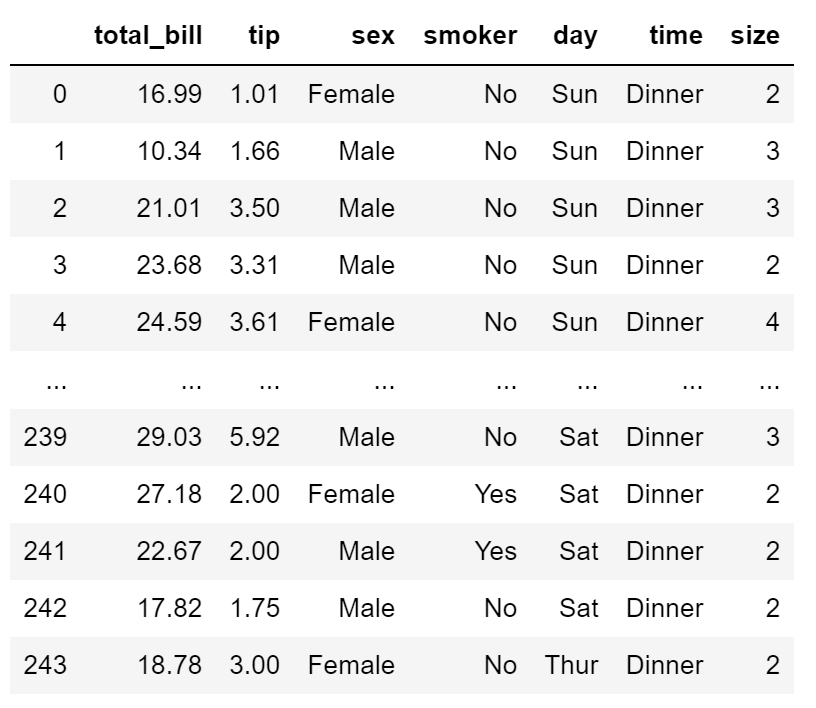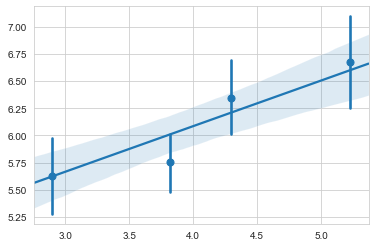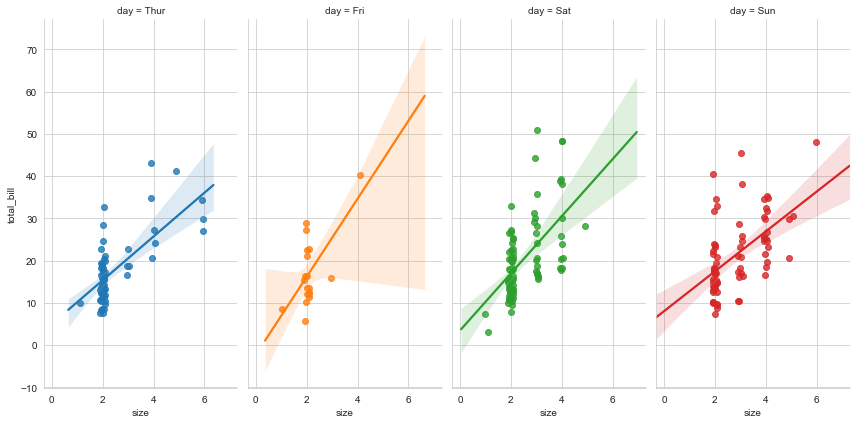Seaborn线性关系数据可视化
regplot()
绘制两个变量的线性拟合图。
sns.regplot(
x,
y,
data=None,
x_estimator=None,
x_bins=None,
x_ci='ci',
scatter=True,
fit_reg=True,
ci=95,
n_boot=1000,
units=None,
order=1,
logistic=False,
lowess=False,
robust=False,
logx=False,
x_partial=None,
y_partial=None,
truncate=False,
dropna=True,
x_jitter=None,
y_jitter=None,
label=None,
color=None,
marker='o',
scatter_kws=None,
line_kws=None,
ax=None,
)
Docstring:
Plot data and a linear regression model fit.
There are a number of mutually exclusive options for estimating the
regression model. See the :ref:`tutorial <regression_tutorial>` for more
information.
Parameters
----------
x, y: string, series, or vector array
Input variables. If strings, these should correspond with column names
in ``data``. When pandas objects are used, axes will be labeled with
the series name.
data : DataFrame
Tidy ("long-form") dataframe where each column is a variable and each
row is an observation.
x_estimator : callable that maps vector -> scalar, optional
Apply this function to each unique value of ``x`` and plot the
resulting estimate. This is useful when ``x`` is a discrete variable.
If ``x_ci`` is given, this estimate will be bootstrapped and a
confidence interval will be drawn.
x_bins : int or vector, optional
Bin the ``x`` variable into discrete bins and then estimate the central
tendency and a confidence interval. This binning only influences how
the scatterplot is drawn; the regression is still fit to the original
data. This parameter is interpreted either as the number of
evenly-sized (not necessary spaced) bins or the positions of the bin
centers. When this parameter is used, it implies that the default of
``x_estimator`` is ``numpy.mean``.
x_ci : "ci", "sd", int in [0, 100] or None, optional
Size of the confidence interval used when plotting a central tendency
for discrete values of ``x``. If ``"ci"``, defer to the value of the
``ci`` parameter. If ``"sd"``, skip bootstrapping and show the
standard deviation of the observations in each bin.
scatter : bool, optional
If ``True``, draw a scatterplot with the underlying observations (or
the ``x_estimator`` values).
fit_reg : bool, optional
If ``True``, estimate and plot a regression model relating the ``x``
and ``y`` variables.
ci : int in [0, 100] or None, optional
Size of the confidence interval for the regression estimate. This will
be drawn using translucent bands around the regression line. The
confidence interval is estimated using a bootstrap; for large
datasets, it may be advisable to avoid that computation by setting
this parameter to None.
n_boot : int, optional
Number of bootstrap resamples used to estimate the ``ci``. The default
value attempts to balance time and stability; you may want to increase
this value for "final" versions of plots.
units : variable name in ``data``, optional
If the ``x`` and ``y`` observations are nested within sampling units,
those can be specified here. This will be taken into account when
computing the confidence intervals by performing a multilevel bootstrap
that resamples both units and observations (within unit). This does not
otherwise influence how the regression is estimated or drawn.
order : int, optional
If ``order`` is greater than 1, use ``numpy.polyfit`` to estimate a
polynomial regression.
logistic : bool, optional
If ``True``, assume that ``y`` is a binary variable and use
``statsmodels`` to estimate a logistic regression model. Note that this
is substantially more computationally intensive than linear regression,
so you may wish to decrease the number of bootstrap resamples
(``n_boot``) or set ``ci`` to None.
lowess : bool, optional
If ``True``, use ``statsmodels`` to estimate a nonparametric lowess
model (locally weighted linear regression). Note that confidence
intervals cannot currently be drawn for this kind of model.
robust : bool, optional
If ``True``, use ``statsmodels`` to estimate a robust regression. This
will de-weight outliers. Note that this is substantially more
computationally intensive than standard linear regression, so you may
wish to decrease the number of bootstrap resamples (``n_boot``) or set
``ci`` to None.
logx : bool, optional
If ``True``, estimate a linear regression of the form y ~ log(x), but
plot the scatterplot and regression model in the input space. Note that
``x`` must be positive for this to work.
{x,y}_partial : strings in ``data`` or matrices
Confounding variables to regress out of the ``x`` or ``y`` variables
before plotting.
truncate : bool, optional
By default, the regression line is drawn to fill the x axis limits
after the scatterplot is drawn. If ``truncate`` is ``True``, it will
instead by bounded by the data limits.
{x,y}_jitter : floats, optional
Add uniform random noise of this size to either the ``x`` or ``y``
variables. The noise is added to a copy of the data after fitting the
regression, and only influences the look of the scatterplot. This can
be helpful when plotting variables that take discrete values.
label : string
Label to apply to ether the scatterplot or regression line (if
``scatter`` is ``False``) for use in a legend.
color : matplotlib color
Color to apply to all plot elements; will be superseded by colors
passed in ``scatter_kws`` or ``line_kws``.
marker : matplotlib marker code
Marker to use for the scatterplot glyphs.
{scatter,line}_kws : dictionaries
Additional keyword arguments to pass to ``plt.scatter`` and
``plt.plot``.
ax : matplotlib Axes, optional
Axes object to draw the plot onto, otherwise uses the current Axes.
Returns
-------
ax : matplotlib Axes
The Axes object containing the plot.
See Also
--------
lmplot : Combine :func:`regplot` and :class:`FacetGrid` to plot multiple
linear relationships in a dataset.
jointplot : Combine :func:`regplot` and :class:`JointGrid` (when used with
``kind="reg"``).
pairplot : Combine :func:`regplot` and :class:`PairGrid` (when used with
``kind="reg"``).
residplot : Plot the residuals of a linear regression model.
#设置风格
sns.set_style('whitegrid')
#导入数据
tips = sns.load_dataset('tips', data_home='seaborn-data')
tips

#回归图
#regplot()
ax = sns.regplot(x='total_bill', y='tip', data=tips)

#离散回归图
ax = sns.regplot(x='size', y='total_bill', data=tips)

#离散回归图
#x_estimator设置离散数据显示的方式(mean表示平均值),ci置信区间默认95%
ax = sns.regplot(x='size', y='total_bill', data=tips, x_estimator=np.mean)

#创建正态分布的数组
np.random.seed(8)
mean = (4, 6)
cov = [[1.5,0.7], [0.7,1]]
x,y = np.random.multivariate_normal(mean, cov, 100).T
#绘制回归图
ax= sns.regplot(x=x, y=y, color='g')

#ci设置置信区间(68表示68%)
ax = sns.regplot(x=x, y=y, ci=68)

#robust设置稳健回归,ci=None设置不显示置信区间
ax = sns.regplot(x=x, y=y, robust=True, ci=None)

#x_bins把连续数据分割为离散数据
ax = sns.regplot(x=x, y=y, x_bins=4)

#非线性拟合:order设置拟合的项次(1表示线性,2,3,4...非线性)
ax = sns.regplot(x=x, y=y, order=2)

#转换成pandas Series数据格式
px = pd.Series(x, name='x_var')
py = pd.Series(y, name='y_var')
ax = sns.regplot(x=px, y=py, marker='+')

#logistic regression 逻辑回归
tips['big_tip'] = (tips.tip / tips.total_bill) > 0.175
ax = sns.regplot(x='total_bill', y='big_tip', data=tips,
logistic=True, n_boot=500, y_jitter=0.03)

#对数回归log
ax = sns.regplot(x='size', y='total_bill', data=tips,
x_estimator=np.mean, logx=True)

lmplot()
与regplot()功能相似,但结合regplot() 与 FacetGrid 功能。
sns.lmplot(
x,
y,
data,
hue=None,
col=None,
row=None,
palette=None,
col_wrap=None,
height=5,
aspect=1,
markers='o',
sharex=True,
sharey=True,
hue_order=None,
col_order=None,
row_order=None,
legend=True,
legend_out=True,
x_estimator=None,
x_bins=None,
x_ci='ci',
scatter=True,
fit_reg=True,
ci=95,
n_boot=1000,
units=None,
order=1,
logistic=False,
lowess=False,
robust=False,
logx=False,
x_partial=None,
y_partial=None,
truncate=False,
x_jitter=None,
y_jitter=None,
scatter_kws=None,
line_kws=None,
size=None,
)
Docstring:
Plot data and regression model fits across a FacetGrid.
This function combines :func:`regplot` and :class:`FacetGrid`. It is
intended as a convenient interface to fit regression models across
conditional subsets of a dataset.
When thinking about how to assign variables to different facets, a general
rule is that it makes sense to use ``hue`` for the most important
comparison, followed by ``col`` and ``row``. However, always think about
your particular dataset and the goals of the visualization you are
creating.
There are a number of mutually exclusive options for estimating the
regression model. See the :ref:`tutorial <regression_tutorial>` for more
information.
The parameters to this function span most of the options in
:class:`FacetGrid`, although there may be occasional cases where you will
want to use that class and :func:`regplot` directly.
Parameters
----------
x, y : strings, optional
Input variables; these should be column names in ``data``.
data : DataFrame
Tidy ("long-form") dataframe where each column is a variable and each
row is an observation.
hue, col, row : strings
Variables that define subsets of the data, which will be drawn on
separate facets in the grid. See the ``*_order`` parameters to control
the order of levels of this variable.
palette : palette name, list, or dict, optional
Colors to use for the different levels of the ``hue`` variable. Should
be something that can be interpreted by :func:`color_palette`, or a
dictionary mapping hue levels to matplotlib colors.
col_wrap : int, optional
"Wrap" the column variable at this width, so that the column facets
span multiple rows. Incompatible with a ``row`` facet.
height : scalar, optional
Height (in inches) of each facet. See also: ``aspect``.
aspect : scalar, optional
Aspect ratio of each facet, so that ``aspect * height`` gives the width
of each facet in inches.
markers : matplotlib marker code or list of marker codes, optional
Markers for the scatterplot. If a list, each marker in the list will be
used for each level of the ``hue`` variable.
share{x,y} : bool, 'col', or 'row' optional
If true, the facets will share y axes across columns and/or x axes
across rows.
{hue,col,row}_order : lists, optional
Order for the levels of the faceting variables. By default, this will
be the order that the levels appear in ``data`` or, if the variables
are pandas categoricals, the category order.
legend : bool, optional
If ``True`` and there is a ``hue`` variable, add a legend.
legend_out : bool, optional
If ``True``, the figure size will be extended, and the legend will be
drawn outside the plot on the center right.
x_estimator : callable that maps vector -> scalar, optional
Apply this function to each unique value of ``x`` and plot the
resulting estimate. This is useful when ``x`` is a discrete variable.
If ``x_ci`` is given, this estimate will be bootstrapped and a
confidence interval will be drawn.
x_bins : int or vector, optional
Bin the ``x`` variable into discrete bins and then estimate the central
tendency and a confidence interval. This binning only influences how
the scatterplot is drawn; the regression is still fit to the original
data. This parameter is interpreted either as the number of
evenly-sized (not necessary spaced) bins or the positions of the bin
centers. When this parameter is used, it implies that the default of
``x_estimator`` is ``numpy.mean``.
x_ci : "ci", "sd", int in [0, 100] or None, optional
Size of the confidence interval used when plotting a central tendency
for discrete values of ``x``. If ``"ci"``, defer to the value of the
``ci`` parameter. If ``"sd"``, skip bootstrapping and show the
standard deviation of the observations in each bin.
scatter : bool, optional
If ``True``, draw a scatterplot with the underlying observations (or
the ``x_estimator`` values).
fit_reg : bool, optional
If ``True``, estimate and plot a regression model relating the ``x``
and ``y`` variables.
ci : int in [0, 100] or None, optional
Size of the confidence interval for the regression estimate. This will
be drawn using translucent bands around the regression line. The
confidence interval is estimated using a bootstrap; for large
datasets, it may be advisable to avoid that computation by setting
this parameter to None.
n_boot : int, optional
Number of bootstrap resamples used to estimate the ``ci``. The default
value attempts to balance time and stability; you may want to increase
this value for "final" versions of plots.
units : variable name in ``data``, optional
If the ``x`` and ``y`` observations are nested within sampling units,
those can be specified here. This will be taken into account when
computing the confidence intervals by performing a multilevel bootstrap
that resamples both units and observations (within unit). This does not
otherwise influence how the regression is estimated or drawn.
order : int, optional
If ``order`` is greater than 1, use ``numpy.polyfit`` to estimate a
polynomial regression.
logistic : bool, optional
If ``True``, assume that ``y`` is a binary variable and use
``statsmodels`` to estimate a logistic regression model. Note that this
is substantially more computationally intensive than linear regression,
so you may wish to decrease the number of bootstrap resamples
(``n_boot``) or set ``ci`` to None.
lowess : bool, optional
If ``True``, use ``statsmodels`` to estimate a nonparametric lowess
model (locally weighted linear regression). Note that confidence
intervals cannot currently be drawn for this kind of model.
robust : bool, optional
If ``True``, use ``statsmodels`` to estimate a robust regression. This
will de-weight outliers. Note that this is substantially more
computationally intensive than standard linear regression, so you may
wish to decrease the number of bootstrap resamples (``n_boot``) or set
``ci`` to None.
logx : bool, optional
If ``True``, estimate a linear regression of the form y ~ log(x), but
plot the scatterplot and regression model in the input space. Note that
``x`` must be positive for this to work.
{x,y}_partial : strings in ``data`` or matrices
Confounding variables to regress out of the ``x`` or ``y`` variables
before plotting.
truncate : bool, optional
By default, the regression line is drawn to fill the x axis limits
after the scatterplot is drawn. If ``truncate`` is ``True``, it will
instead by bounded by the data limits.
{x,y}_jitter : floats, optional
Add uniform random noise of this size to either the ``x`` or ``y``
variables. The noise is added to a copy of the data after fitting the
regression, and only influences the look of the scatterplot. This can
be helpful when plotting variables that take discrete values.
{scatter,line}_kws : dictionaries
Additional keyword arguments to pass to ``plt.scatter`` and
``plt.plot``.
See Also
--------
regplot : Plot data and a conditional model fit.
FacetGrid : Subplot grid for plotting conditional relationships.
pairplot : Combine :func:`regplot` and :class:`PairGrid` (when used with
``kind="reg"``).
#回归图
ax = sns.lmplot(x='total_bill', y='tip', data=tips)

#hue添加分类, markers设置散点样式
ax = sns.lmplot(x='total_bill', y='tip',
hue="smoker", data=tips,
markers=['o','x']
)

#palette设置调色板
ax = sns.lmplot(x='total_bill', y='tip',
hue='smoker', data=tips,
palette='Set1'
)

#palette设置调色板
ax = sns.lmplot(x='total_bill', y='tip',
hue='smoker', data=tips,
palette=dict(Yes='g', No='m')
)

#col设置分栏绘制
ax = sns.lmplot(x='total_bill', y='tip',
col='smoker', data=tips
)

#heigtht图高,aspect宽/高比例,x_jitter添加数据噪点
ax = sns.lmplot(x='size', y='total_bill', hue='day',
col='day', data=tips,
height=6, aspect=0.5,
x_jitter=.1
)

#col_wrap设置多行显示
ax = sns.lmplot(x='total_bill', y='tip', hue='day',
col='day', data=tips,
col_wrap=2, height=3
)

#多行多栏显示
ax = sns.lmplot(x='total_bill', y='tip',
row='sex', col='time',
data=tips, height=3
)

ax = sns.lmplot(x='total_bill', y='tip',
row='sex', col='time',
data=tips, height=3
)
#设置图形参数
ax = ax.set_axis_labels("Total bill (US Dollars)", "Tip")
ax = ax.set(xlim=(0,60), ylim=(0,12),
xticks=[10, 30, 50], yticks=[2, 6, 10])
ax = ax.fig.subplots_adjust(wspace=.02)







【推荐】国内首个AI IDE,深度理解中文开发场景,立即下载体验Trae
【推荐】编程新体验,更懂你的AI,立即体验豆包MarsCode编程助手
【推荐】抖音旗下AI助手豆包,你的智能百科全书,全免费不限次数
【推荐】轻量又高性能的 SSH 工具 IShell:AI 加持,快人一步
· 震惊!C++程序真的从main开始吗?99%的程序员都答错了
· 【硬核科普】Trae如何「偷看」你的代码?零基础破解AI编程运行原理
· 单元测试从入门到精通
· 上周热点回顾(3.3-3.9)
· winform 绘制太阳,地球,月球 运作规律